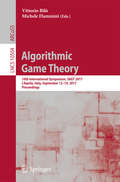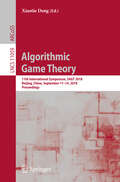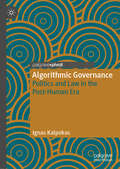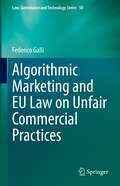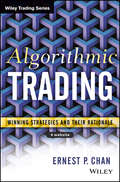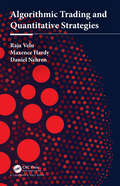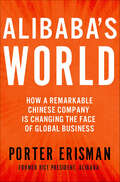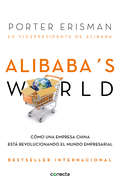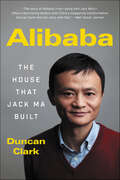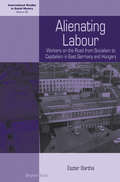- Table View
- List View
Algorithmic Game Theory: 10th International Symposium, SAGT 2017, L’Aquila, Italy, September 12–14, 2017, Proceedings (Lecture Notes in Computer Science #10504)
by Vittorio Bilò Michele FlamminiThis book constitutes the refereed proceedings of the 10th International Symposium on Algorithmic Game Theory, SAGT 2017, held in L'Aquila, Italy, in September 2017.The 30 full papers presented were carefully reviewed and selected from 66 submissions. The papers cover various important aspects of algorithmic game theory such as auctions, computational aspects of games, congestion games, network and opinion formation games, mechanism design, incentives and regret minimization, and resource allocation.
Algorithmic Game Theory: 11th International Symposium, SAGT 2018, Beijing, China, September 11-14, 2018, Proceedings (Lecture Notes in Computer Science #11059)
by Xiaotie DengThis book constitutes the refereed proceedings of the 11th International Symposium on Algorithmic Game Theory, SAGT 2018, held in Beijing, China, in September 2018. The 19 full papers presented together with 6 short papers and 5 plenary talks were carefully reviewed and selected from 54 submissions. The papers cover various important aspects of algorithmic game theory including market equilibrium, auctions and applications, two sided markets, cake-cutting, cooperative games, voting games, multi-agent scheduling, price of stability, various mechanism design problems: online-dynamics and multi-stages as well as revenue maximization and resource allocation and applications.
Algorithmic Governance: Politics and Law in the Post-Human Era
by Ignas KalpokasThis book analyses the changes to the regulation of everyday life that have taken place as a result of datafication, the ever-growing analytical, predictive, and structuring role of algorithms, and the prominence of the platform economy. This new form of regulation – algorithmic governance – ranges from nudging individuals towards predefined outcomes to outright structuration of behaviour through digital architecture. The author reveals the strength and pervasiveness of algorithmic politics through a comparison with the main traditional form of regulation: law. These changes are subsequently demonstrated to reflect a broader shift away from anthropocentric accounts of the world. In doing so, the book adopts a posthumanist framework which focuses on deep embeddedness and interactions between humans, the natural environment, technology, and code.
Algorithmic Marketing and EU Law on Unfair Commercial Practices (Law, Governance and Technology Series #50)
by Federico GalliArtificial Intelligence (AI) systems are increasingly being deployed by marketing entities in connection with consumers’ interactions. Thanks to machine learning (ML) and cognitive computing technologies, businesses can now analyse vast amounts of data on consumers, generate new knowledge, use it to optimize certain processes, and undertake tasks that were previously impossible.Against this background, this book analyses new algorithmic commercial practices, discusses their challenges for consumers, and measures such developments against the current EU legislative framework on consumer protection. The book adopts an interdisciplinary approach, building on empirical findings from AI applications in marketing and theoretical insights from marketing studies, and combining them with normative analysis of privacy and consumer protection in the EU.The content is divided into three parts. The first part analyses the phenomenon of algorithmic marketing practices and reviews the main AI and AI-related technologies used in marketing, e.g. Big data, ML and NLP. The second part describes new commercial practices, including the massive monitoring and profiling of consumers, the personalization of advertising and offers, the exploitation of psychological and emotional insights, and the use of human-like interfaces to trigger emotional responses. The third part provides a comprehensive analysis of current EU consumer protection laws and policies in the field of commercial practices. It focuses on two main legal concepts, their shortcomings, and potential refinements: vulnerability, understood as the conceptual benchmark for protecting consumers from unfair algorithmic practices; manipulation, the substantive legal measure for drawing the line between fair and unfair practices.
Algorithmic Trading
by Ernie ChanPraise for Algorithmic Trading"Algorithmic Trading is an insightful book on quantitative trading written by a seasoned practitioner. What sets this book apart from many others in the space is the emphasis on real examples as opposed to just theory. Concepts are not only described, they are brought to life with actual trading strategies, which give the reader insight into how and why each strategy was developed, how it was implemented, and even how it was coded. This book is a valuable resource for anyone looking to create their own systematic trading strategies and those involved in manager selection, where the knowledge contained in this book will lead to a more informed and nuanced conversation with managers."-DAREN SMITH, CFA, CAIA, FSA, Managing Director, Manager Selection & Portfolio Construction, University of Toronto Asset Management"Using an excellent selection of mean reversion and momentum strategies, Ernie explains the rationale behind each one, shows how to test it, how to improve it, and discusses implementation issues. His book is a careful, detailed exposition of the scientific method applied to strategy development. For serious retail traders, I know of no other book that provides this range of examples and level of detail. His discussions of how regime changes affect strategies, and of risk management, are invaluable bonuses."-Roger Hunter, Mathematician and Algorithmic Trader
Algorithmic Trading and Quantitative Strategies
by Raja VeluAlgorithmic Trading and Quantitative Strategies provides an in-depth overview of this growing field with a unique mix of quantitative rigor and practitioner’s hands-on experience. The focus on empirical modeling and practical know-how makes this book a valuable resource for students and professionals. The book starts with the often overlooked context of why and how we trade via a detailed introduction to market structure and quantitative microstructure models. The authors then present the necessary quantitative toolbox including more advanced machine learning models needed to successfully operate in the field. They next discuss the subject of quantitative trading, alpha generation, active portfolio management and more recent topics like news and sentiment analytics. The last main topic of execution algorithms is covered in detail with emphasis on the state of the field and critical topics including the elusive concept of market impact. The book concludes with a discussion on the technology infrastructure necessary to implement algorithmic strategies in large-scale production settings. A git-hub repository includes data-sets and explanatory/exercise Jupyter notebooks. The exercises involve adding the correct code to solve the particular analysis/problem.
Algorithmic and High-Frequency Trading
by Álvaro Cartea Sebastian Jaimungal José PenalvaThe design of trading algorithms requires sophisticated mathematical models backed up by reliable data. <P><P> In this textbook, the authors develop models for algorithmic trading in contexts such as executing large orders, market making, targeting VWAP and other schedules, trading pairs or collection of assets, and executing in dark pools. These models are grounded on how the exchanges work, whether the algorithm is trading with better informed traders (adverse selection), and the type of information available to market participants at both ultra-high and low frequency. Algorithmic and High-Frequency Trading is the first book that combines sophisticated mathematical modelling, empirical facts and financial economics, taking the reader from basic ideas to cutting-edge research and practice. If you need to understand how modern electronic markets operate, what information provides a trading edge, and how other market participants may affect the profitability of the algorithms, then this is the book for you.
Algorithms from and for Nature and Life: Classification and Data Analysis (Studies in Classification, Data Analysis, and Knowledge Organization)
by Berthold Lausen Alfred Ultsch Dirk Van den PoelThis volume provides approaches and solutions to challenges occurring at the interface of research fields such as, e.g., data analysis, data mining and knowledge discovery, computer science, operations research, and statistics. In addition to theory-oriented contributions various application areas are included. Moreover, traditional classification research directions concerning network data, graphs, and social relationships as well as statistical musicology describe examples for current interest fields tackled by the authors. The book comprises a total of 55 selected papers presented at the Joint Conference of the German Classification Society (GfKl), the German Association for Pattern Recognition (DAGM), and the Symposium of the International Federation of Classification Societies (IFCS) in 2011.
Algramo
by Michael Chu Monica Silva Mariana CalThe company's innovative approach was widely recognized, both locally and internationally. In 2018, Moller was invited to join a prestigious NGO focused on the role of the private sector, which led to an invitation by Unilever Chile's CEO to join forces to meet a corporate-wide Unilever commitment: a 25% reduction by 2025 of the plastics it put out into the world. One of the most efficient ways of doing so was the replacement of single-use plastic packaging by reusable containers, but the challenge was to make consumers remember to take their empty containers with them when shopping. With the insight that people never forget to take their wallets, Moller's response was Packaging-as-a-Wallet (PaaW), a reusable plastic container imbedded with a Radio Frequency Identification (RFID) chip that, through Algramo's smartphone app, could also become a digital wallet. At the same time, the app allowed the user to order the exact amount desired and have it home-delivered by electric tricycle. In January 2020, following a successful pilot test, Unilever Chile and Algramo rolled out PaaW across Santiago, Chile's capital. With plastic pollution a highly visible global issue, Algramo's efforts attracted wide international attention and recognition. Several leading FMCG multinationals and environmental NGOs approached Algramo to explore potential partnerships. For many years, Algramo's financing came through awards and prizes, friends and family and benefactors. At the end of 2019, Algramo completed its first institutional capital-raise in a round led by New York-based impact investor Closed Loop Partners. That relationship opened the doors to projects that would take the Algramo model to New York City. In March 2020, Algramo's board approved a joint venture with a Dutch NGO to deploy Algramo in Indonesia, the world's second-largest source of plastic leakage into the oceans. That same month, Chile registered its first Covid-19 case.
Aliados y adversarios: 1988 - 2017
by Carlos Salinas de Gortari"'Matar el TLCAN' acarrearía muchos conflictos, entre ellos la pérdida de millones de empleos en Estados Unidos. Para México, las consecuencias serían aún peores" Carlos Salinas de Gortari En este libro, el expresidente Carlos Salinas de Gortari narra con agilidad la historia de un acuerdo que definió el rostro de México rumbo al siglo XXI: el Tratado de Libre Comercio de América del Norte. Relatada casi como una crónica de aventuras, esta obra es también la narración política y el recuerdo privado de la persona que propuso, cabildeó y concretó el TLCAN. Es éste un análisis que recuerda la importancia estratégica del tratado, los pormenores de su negociación, los resultados que ha entregado a lo largo de 24 años y el embate que ha sufrido por el gobierno de Donald Trump. Por ello, se trata de un libro urgente, que analiza el pasado, el presente y el futuro de un pacto comercial clave para más de 450 millones de personas en Canadá, Estados Unidos y México. Aliados y adversarios conjuga argumentos de fondo y datos concretos con la historia personal de un protagonista para resaltar la importancia de un tratado que definió el escenario de modernidad y globalización en el que vivimos actualmente.
Alibaba Goes Public (A)
by David Lane Krishna G. Palepu Suraj Srinivasan Charles C.Y. WangIn 2014 Alibaba debuted on the New York Stock Exchange, creating not only the largest IPO in history but this initial desire to list on the Hong Kong Stock Exchange was denied due to the company's desire to preserve its partner's control over decision rights. Why did Hong Kong deny Alibaba's requests to list dual-class shares or to allow its partners to nominate a majority of the board of directors, and in the process turn away a superstar in Alibaba? Why did American stock markets approve of Alibaba's governance structures, despite the warnings of many governance experts? How can investors ensure that their capital would be deployed effectively by the company's top management?
Alibaba Goes Public (B)
by David Lane Krishna G. Palepu Suraj Srinivasan Charles C.Y. WangUpdate on Alibaba Group's share price performance and related events in the year following its September 2014 IPO.
Alibaba Group
by Julie M. WulfDiscusses how Alibaba Group successfully managed new business ventures to become a leader in China's online marketplaces. Students follow Alibaba Group's transition from a startup to a multibusiness firm with over 15,000 employees in just over a decade. They analyze the evolving dynamics of internal competition and cooperation among Alibaba Group's subsidiaries. Students are also asked to address Alibaba Group's strategy, the role of its corporate center and how to incentivize subsidiary executives.
Alibaba and the Future of Business: Alibaba, The Future Of Strategy, And What It Means For You
by Ming ZengFeature
Alibaba's Taobao (A)
by Felix Oberholzer-Gee Julie M. WulfExamines the decision of Alibaba Group to diversify from an international business-to-business (B2B) exchange (Alibaba.com) into a B2C and C2C exchange (Taobao.com) for Chinese retailers and consumers. In China, Taobao had managed to displace the once dominant eBay, the world's largest consumer marketplace. However, the company had little revenue because it offered services free of charge.
Alibaba's World: How a Remarkable Chinese Company Is Changing the Face of Global Business
by Porter ErismanIn September 2014, a Chinese company that most Americans had never heard of held the largest IPO in history – bigger than Google, Facebook and Twitter combined. Alibaba, now the world's largest e-commerce company, mostly escaped Western notice for over ten years, while building a customer base more than twice the size of Amazon's, and handling the bulk of e-commerce transactions in China. How did it happen? And what was it like to be along for such a revolutionary ride?In Alibaba's World, author Porter Erisman, one of Alibaba's first Western employees and its head of international marketing from 2000 to 2008, shows how Jack Ma, a Chinese schoolteacher who twice failed his college entrance exams, rose from obscurity to found Alibaba and lead it from struggling startup to the world's most dominant e-commerce player. He shares stories of weathering the dotcom crash, facing down eBay and Google, negotiating with the unpredictable Chinese government, and enduring the misguided advice of foreign experts, all to build the behemoth that's poised to sweep the ecommerce world today. And he analyzes Alibaba's role as a harbinger of the new global business landscape—with its focus on the East rather than the West, emerging markets over developed ones, and the nimble entrepreneur over the industry titan. As we face this near future, the story of Alibaba—and its inevitable descendants—is both essential and instructive.
Alibaba's world: Cómo una empresa china está revolucionando el mundo empresarial
by Porter ErismanLa oferta pública inicial más grande de la historia, más aún que Google, Facebook y Twitter combinados, se celebró en septiembre de 2014, por una compañía china de la cual la mayoría de los occidentales nunca había oído hablar. Alibaba, ahora la empresa de comercio electrónico más grande del mundo, escapó de la atención del mundo occidental durante más de diez años, mientras construía una base de clientes que sumaba más del doble de la de Amazon y se encargaba de la mayor parte de las transacciones de comercio electrónico en China. ¿Cómo pasó? ¿Y qué significó ser parte de tan revolucionario proyecto? En este libro, Porter Erisman, uno de los primeros empleados occidentales de Alibaba y jefe de marketing internacional entre 2000 y 2008, muestra cómo Jack Ma se levantó de la oscuridad para fundar Alibaba y dirigirla, desde que era una startup en dificultades hasta convertirse en el jugador de comercio electrónico más dominante del mundo. A partir de historias sobre cómo resistió el desplome de las puntocom, enfrentó a eBay y Google, negoció con el impredecible gobierno chino y soportó los consejos equivocados de expertos extranjeros, el autor analiza el papel de Alibaba como un heraldo del nuevo panorama global de negocios, con su enfoque en Oriente en lugar de Occidente, en los mercados emergentes sobre los desarrollados, y el ágil emprendedor sobre el titán de la industria.
Alibaba: The House That Jack Ma Built
by Duncan ClarkIn just a decade and half Jack Ma, a man who rose from humble beginnings and started his career as an English teacher, founded and built Alibaba into the second largest Internet company in the world. The company’s $25 billion IPO in 2014 was the world’s largest, valuing the company more than Facebook or Coca Cola. Alibaba today runs the e-commerce services that hundreds of millions of Chinese consumers depend on every day, providing employment and income for tens of millions more. A Rockefeller of his age, Jack has become an icon for the country’s booming private sector, and as the face of the new, consumerist China is courted by heads of state and CEOs from around the world.Granted unprecedented access to a wealth of new material including exclusive interviews, Clark draws on his own first-hand experience of key figures integral to Alibaba’s rise to create an authoritative, compelling narrative account of how Alibaba and its charismatic creator have transformed the way that Chinese exercise their new found economic freedom, inspiring entrepreneurs around the world and infuriating others, turning the tables on the Silicon Valley giants who have tried to stand in his way. Duncan explores vital questions about the company’s past, present, and future: How, from such unremarkable origins, did Jack Ma build Alibaba? What explains his relentless drive and his ability to outsmart his competitors? With over 80% of China’s e-commerce market, how long can the company hope to maintain its dominance? As the company sets its sights on the country’s financial and media markets, are there limits to Alibaba’s ambitions, or will the Chinese government act to curtail them? And as it set up shop from LA and San Francisco to Seattle, how will Alibaba grow its presence and investments in the US and other international markets?Clark tells Alibaba’s tale within the wider story of China’s economic explosion—the rise of the private sector and the expansion of Internet usage—that haver powered the country’s rise to become the world’s second largest economy and largest Internet population, twice the size of the United States. He also explores the political and social context for these momentous changes. An expert insider with unrivaled connections, Clark has a deep understanding of Chinese business mindset. He illuminates an unlikely corporate titan as never before, and examines the key role his company has played in transforming China while increasing its power and presence worldwide.
Alibris (A)
by Andrew Mcafee Kerry HermanAlibris is an Internet-era company providing search and fulfillment services for hard-to-find (rare, used, and out-of-print) books. At the time of the case, the company had made decisions to change its revenue model, to become involved in the fulfillment process for each book it sells by establishing a cross-dock facility, and to purchase Oracle's Internet commerce software. However, the implementation of this software has been very difficult, delaying the launch of the new fulfillment business and costing large amounts of money at a time when cash is scarce. The company's leaders, who are not IT professionals, must decide whether to continue with Oracle or begin anew with another product.
Alibris (B)
by Andrew McafeeTakes place more than two years after the (A) case. Alibris has weathered the storms and has built a popular, growing business. As the Christmas season of 2000 approaches, the company is confronted with two IT projects that both seem urgent and important. The first is an effort to replace the software tool used by book dealers and others to upload their listing to the Alibris database. The current tool is error prone and does not provide rich information about each book uploaded. This lack of rich information makes useful searches of the Alibris database difficult. The second project involves ensuring the integrity of the database itself. Recent evidence suggests that records are not being uploaded, updated, and deleted as they should be in all cases, with adverse effects for customers. Alibris must decide which of the two projects to pursue immediately. There are not enough resources to do both.
Alibris in 2004
by Andrew McafeeAlibris, an online marketplace for rare, used, and out-of-print books, is trying to communicate to the professional book dealers who are its main suppliers that they are in the middle of a crisis. Supply is flooding the market, in part from individuals who simply want to clean out their bookshelves and make a bit of money. These individuals' sales are facilitated by a number of online merchants, including Alibris, Half.com, Amazon.com, and eBay. Alibris has built a number of powerful capabilities to help both buyers and sellers of books. Among these is a pricing service that allows sellers to set market prices for their books automatically. Alibris wants to encourage its dealers to use this service: the problem is that most market prices are far below the prices dealers have set for their books.
Alicia Keys
by Boris Groysberg Annelena Lobb Sarah MehtaThis case explores the life and career of Alicia Keys, the 15-time Grammy winning singer-songwriter and producer. Set in 2019, it covers the evolution of Keys's 18-year musical career and additional passions, including acting, entrepreneurship, social justice activism, and collecting art with her husband, rapper and music producer Swizz Beatz. Now a mother of two young sons and with no intentions of slowing down, Keys considers what the next phase of her life and career might hold. This case would be useful for students studying the music and entertainment industry. It also holds relevance for executives approaching the peak of their career and looking to make more deliberate decisions about time management and prioritization.
Alienating Labour: Workers on the Road from Socialism to Capitalism in East Germany and Hungary (International Studies in Social History #22)
by Eszter BarthaThe Communist Party dictatorships in Hungary and East Germany sought to win over the “masses” with promises of providing for ever-increasing levels of consumption. This policy—successful at the outset—in the long-term proved to be detrimental for the regimes because it shifted working class political consciousness to the right while it effectively excluded leftist alternatives from the public sphere. This book argues that this policy can provide the key to understanding of the collapse of the regimes. It examines the case studies of two large factories, Carl Zeiss Jena (East Germany) and Rába in Győr (Hungary), and demonstrates how the study of the formation of the relationship between the workers’ state and the industrial working class can offer illuminating insights into the important issue of the legitimacy (and its eventual loss) of Communist regimes.
Alienation and the Soviet Economy: The Collapse of the Socialist Era
by Paul Craig RobertsIn 1971, Paul Craig Roberts created a firestorm among professional Sovietologists by proclaiming that the economies of the USSR and its East Bloc allies were doomed because their "planned" economies were, in reality, anything but planned.In this revised edition, Paul Craig Roberts examines how reality triumphed over Marxist theory and the implications for the future of Russia and eastern Europe. Expanding on his original ideas, Roberts demonstrates the fatal shortcomings of Marxist economies, ranging from misallocation of resources to ersatz capitalistic concepts grafted onto a system that calls for production without regard to profit. Roberts argues that the economies of the nations emerging from the USSR&’s collapse must grasp the profound truths in this book if they are to become viable.
Align Technology, Inc.: Matching Manufacturing Capacity to Sales Demand
by H. Kent Bowen Jonathan P. GrobergAlign Technology is a four-year-old medical products company that has invented a new product requiring new manufacturing processes. Demand for the new product has grown more slowly than initial forecasts predicted, and the cost structure is preventing the company from becoming profitable. The manufacturing process involves six different operations located in California, Pakistan, and Mexico. The first dilemma requires downsizing the capacity until the demand grows. Increasing capacity in the future requires consideration of the time lags, costs, and incremental units of added capacity inherent in each of the six processes. Given the uncertainty of accurate sales forecasts as the company carries out new marketing initiatives, the manufacturing organization has been challenged to create a capacity plan to meet demand while lowering its fixed costs.
